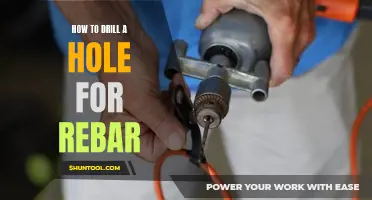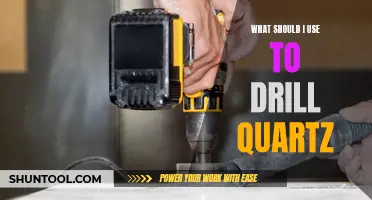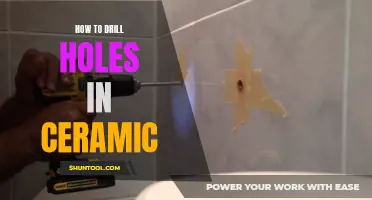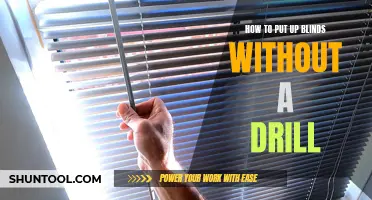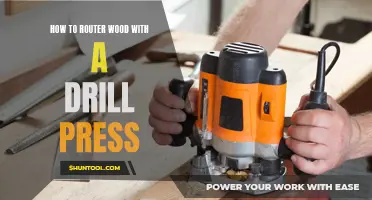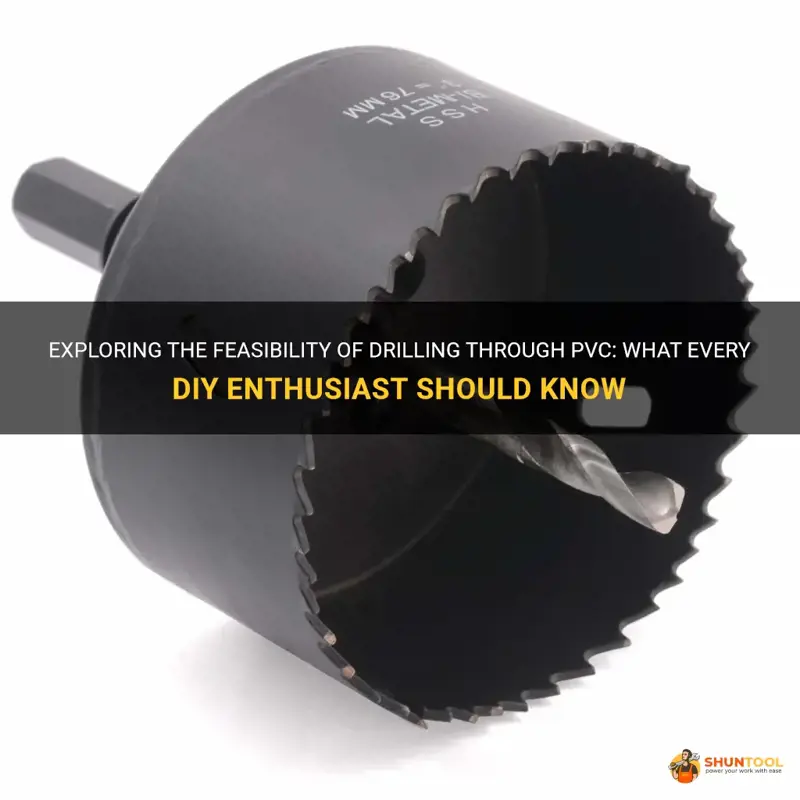
Have you ever wondered if it is possible to drill through PVC pipes? PVC, or polyvinyl chloride, is a common material used in plumbing systems and electrical wiring. While it may seem daunting to drill through such a sturdy material, with the right tools and techniques, drilling through PVC can be a straightforward task. In this article, we will explore the necessary steps and precautions to take when drilling through PVC pipes, ensuring a successful and efficient process. So, if you're curious about drilling through PVC or need to complete a DIY project involving PVC pipes, read on to learn more!
What You'll Learn
- Can I safely drill through PVC pipes without causing damage or leaks?
- What type of drill bit should I use when drilling through PVC?
- Are there any special precautions I should take when drilling through PVC to avoid accidents or injury?
- How can I ensure that the drilled hole in the PVC pipe is precise and clean?
- Are there any alternative methods to drilling through PVC pipes that should be considered?

Can I safely drill through PVC pipes without causing damage or leaks?
PVC pipes are commonly used in plumbing systems due to their durability, affordability, and ease of installation. However, there may come a time when you need to drill through a PVC pipe for various reasons, such as adding a new connection or installing a fixture. It is crucial to approach this task with caution to minimize the risk of damage or leaks. By following proper procedures and taking necessary precautions, you can safely drill through PVC pipes without causing any harm or compromising the integrity of the pipe.
Before you start drilling, make sure you have the necessary tools and equipment. You will need a drill, drill bits suitable for PVC, a marker or pencil, a tape measure, and safety gear such as safety glasses and gloves. It is also helpful to have a steady hand and a clear understanding of the pipe layout to avoid hitting other pipes or objects behind the wall.
Here are the step-by-step instructions to safely drill through a PVC pipe:
- Identify the location: Determine the exact spot where you need to drill the hole. Use a marker or pencil to mark the location on the surface of the PVC pipe. Measure and mark the distance from any adjacent pipes or fittings to ensure you have enough clearance.
- Secure the pipe: If the PVC pipe is accessible, consider clamping it or securing it in place to prevent it from moving while you drill. This will help maintain stability and accuracy during the drilling process.
- Choose the right drill bit: Select a drill bit specifically designed for drilling through PVC. These drill bits often have a sharp, pointed tip and fluted edges that help cut through the PVC material without causing excessive damage.
- Start drilling: Place the drill bit on the marked spot and start drilling slowly. Apply steady and even pressure while keeping the drill perpendicular to the pipe. Avoid using excessive force as it may cause the bit to wander or crack the pipe.
- Use lubrication: As you drill, it's recommended to use a lubricant, such as water or a silicone spray, to reduce heat and friction. This lubrication helps keep the drill bit cool and prevents it from getting stuck or binding.
- Monitor the drilling progress: Frequently check the drilling progress by pulling out the drill bit and inspecting the hole. This will allow you to adjust the drilling speed and pressure if needed, ensuring a clean and accurate hole.
- Clear the debris: After drilling through the PVC pipe, remove any debris or shavings from the hole. A shop vacuum or a clean cloth can be used to clean out the drilled hole.
- Inspect for damage or leaks: Once the drilling is complete, carefully inspect the drilled area for any damage or signs of leaks. Look for cracks, fractures, or distortions in the pipe. If you notice any issues, it's crucial to address them promptly to avoid potential leaks or pipe failure.
By following these steps, you can safely drill through PVC pipes without causing damage or leaks. Remember to wear safety gear, take your time, and have a clear understanding of the pipe layout to ensure a successful drilling operation. If you are unsure about drilling through PVC pipes or encounter any difficulties, it is always advisable to consult a professional plumber for assistance.
Creative Ways to Hang Objects on a Wall without Drilling
You may want to see also

What type of drill bit should I use when drilling through PVC?
Drilling through PVC can be a delicate task if not done correctly. The right drill bit is crucial to ensure a clean and precise hole without causing any damage to the PVC material. In this article, we will discuss the different types of drill bits that are suitable for drilling through PVC and provide some tips to help you achieve the best results.
When drilling through PVC, it is recommended to use a drill bit specifically designed for plastics. These drill bits have a special geometry that helps prevent the material from cracking, chipping, or melting during the drilling process. The most commonly used drill bits for PVC are twist drill bits, brad point bits, and spade bits.
Twist drill bits are a versatile option for drilling through PVC. They have a sharp point and fluted design, which allows them to cut through the material efficiently. When using twist drill bits, it is important to choose a bit with a diameter slightly larger than the size of the hole you need. This will help prevent any binding and ensure a smooth drilling process.
Brad point bits, also known as dowelling bits, are another excellent choice for drilling through PVC. These bits have a sharp, center point that helps guide the bit accurately and prevent any wandering. Brad point bits are particularly useful when drilling precise holes, such as for installing hinges or handles on PVC doors or cabinets.
Spade bits, also called paddle bits, are designed for larger diameter holes in PVC. They have a flat, paddle-shaped cutting edge that quickly cuts through the material. Spade bits are commonly used for drilling holes for pipes or conduits in PVC walls or panels. It is important to note that spade bits can cause more friction and generate more heat compared to other drill bits, so it is essential to apply consistent pressure and avoid overheating the PVC.
Now that you have an idea of the types of drill bits suitable for drilling through PVC, here are some general tips to help you achieve the best results:
- Start by ensuring that your drill is set to the proper speed for drilling through PVC. The speed settings may vary depending on the manufacturer's recommendations, so it is always a good idea to consult the drill's manual.
- Use a center punch or awl to create a small indentation on the surface of the PVC before drilling. This will help the drill bit to grip the material and prevent any wandering.
- Apply steady and even pressure while drilling. Avoid pushing too hard or drilling too fast, as this can cause the PVC to crack or melt. Let the drill bit do the work, and be patient throughout the process.
- Occasionally retract the drill bit to remove any PVC debris that may accumulate in the hole. This will help prevent clogging and ensure a cleaner hole.
- After drilling the hole, deburr the edges using a deburring tool or a chamfering bit. This will remove any rough or sharp edges and give the hole a clean finish.
To illustrate the process, let's consider an example. Suppose you need to install a new towel rack on a PVC wall panel. Start by marking the desired location for the towel rack and use a level to ensure it is straight. Once the marking is done, follow the steps mentioned above to drill the holes using the appropriate drill bit. After drilling the holes, insert wall anchors (if necessary) and secure the towel rack using screws. Finally, check if the towel rack is securely mounted.
In conclusion, selecting the right drill bit and following proper drilling techniques are essential when working with PVC. Using the correct type of drill bit, such as twist drill bits, brad point bits, or spade bits, will help you achieve clean and precise holes without causing any damage to the PVC material. Remember to apply steady pressure, periodically remove debris, and deburr the holes for the best results. With practice and attention to detail, drilling through PVC can be a straightforward and successful task.
Choosing the Right Bolts for Your Drill Press Table: A Comprehensive Guide
You may want to see also

Are there any special precautions I should take when drilling through PVC to avoid accidents or injury?
Drilling through PVC is a common task in construction and DIY projects, but it is important to take special precautions to avoid accidents or injury. PVC, or polyvinyl chloride, is a type of plastic that can release harmful chemicals when heated or disrupted. Additionally, drilling through PVC incorrectly can result in damage to the pipe or other surrounding materials. In this article, we will discuss the precautions you should take when drilling through PVC to ensure your safety and the success of your project.
- Wear protective gear: Before you begin drilling, make sure to equip yourself with appropriate protective gear. This should include safety glasses or goggles to protect your eyes from flying debris, as well as gloves to protect your hands. PVC shavings can be sharp and can cause cuts or abrasions if they come into contact with your skin.
- Use the correct drill bit: It is crucial to use the correct drill bit when drilling through PVC. A standard twist drill bit may not provide the cleanest hole and can cause the pipe to crack or split. Instead, opt for a drill bit specifically designed for plastic or PVC. These drill bits typically have a sharper point and wider flutes, which help to prevent cracking and facilitate chip removal.
- Drill at a low speed: PVC can melt or deform if too much heat is generated during drilling. To avoid this, drill at a low speed. A high-speed drill can generate excess heat, causing the PVC to melt or become misshapen. Set your drill to a slow speed and apply gentle pressure to minimize heat buildup.
- Use a pilot hole: To prevent the drill from slipping or skidding across the surface of the PVC, start by drilling a small pilot hole. This will act as a guide for the larger drill bit and help to keep it on track. Choose a drill bit slightly smaller than the final desired hole size for the pilot hole.
- Secure the PVC: It is important to secure the PVC firmly before drilling. An unsecured pipe can rotate or move during drilling, which can cause the bit to catch and potentially result in injury. Use clamps or a vise to hold the PVC securely in place while drilling.
- Take breaks and clear chips: PVC shavings can accumulate in the hole during drilling, which can cause the bit to bind or overheat. Take regular breaks to clear the chips from the hole using compressed air or a vacuum. This will help to keep the drilling process smooth and prevent overheating.
- Be mindful of surroundings: When drilling through PVC, be aware of what is behind or adjacent to the pipe. For example, if you are drilling near electrical wires, you need to exercise caution to avoid damaging them. Always have a clear understanding of what is on the other side of the pipe before drilling.
In conclusion, drilling through PVC requires special precautions to avoid accidents or injury. By wearing protective gear, using the correct drill bit, drilling at a low speed, using a pilot hole, securing the PVC, taking breaks to clear chips, and being mindful of your surroundings, you can safely and effectively drill through PVC without any issues. Remember to always prioritize safety and follow these guidelines for a successful drilling experience.
Determining the Ideal Height for a Drill Press with Easy Jig Gen 2
You may want to see also

How can I ensure that the drilled hole in the PVC pipe is precise and clean?
Drilling a hole in a PVC pipe may seem like a simple task, but it requires precision and technique to ensure a clean and precise hole. Whether you are installing fittings or creating a custom project, it is essential to follow the proper steps to achieve the desired results. In this article, we will explore the methods and techniques that can help you drill a hole in a PVC pipe with precision and cleanliness.
Choosing the right drill bit:
To achieve a precise and clean hole, it is crucial to select the correct drill bit. For drilling through PVC pipes, a twist drill bit or a hole saw can be used. Twist drill bits are versatile and suitable for smaller holes, while hole saws are ideal for larger diameter holes. Make sure to choose a drill bit size that matches the diameter of the hole you desire.
Marking the drilling location:
Before you begin drilling, mark the exact location where the hole needs to be made. Use a measuring tape or a ruler to ensure accuracy. You can use a pencil or a marker to make a visible mark on the PVC pipe. Double-check the measurements to ensure that the hole will be in the desired position.
Securing the PVC pipe:
To prevent the pipe from spinning or moving during drilling, it's important to secure it in place. You can use clamps or a vise to hold the PVC pipe firmly. This will provide stability and allow you to drill with precision. Make sure the pipe is secured tightly but not so tightly that it damages the pipe.
Lubricating the drill bit:
Applying lubrication before drilling can help reduce friction and prevent the PVC pipe from melting or chipping. You can use a general-purpose cutting oil, lubricating spray, or even soapy water as a lubricant. Apply a small amount to the drill bit to ensure smooth drilling.
Starting the drilling process:
Position the drill bit at the marked location on the PVC pipe. Start drilling at a slow speed to ensure precision. Gradually increase the speed as you progress, but avoid applying excessive force, as it can cause the drill bit to wander or create a jagged hole. Take your time and let the drill bit do the work.
Clearing the debris:
As you drill, PVC shavings and debris may accumulate inside the pipe. Periodically stop drilling to remove the debris using a brush or compressed air. This will prevent clogging and ensure a clean hole.
Finishing the hole:
Once the hole is complete, carefully lift the drill bit out of the pipe. Inspect the hole for any rough edges or burrs. You can use a deburring tool or sandpaper to smoothen the edges if necessary. This will ensure that the pipe retains its structural integrity and prevent any damage to fittings or components that will be inserted into the hole.
It is essential to note that safety precautions should always be followed when drilling. Wear safety goggles to protect your eyes from debris, and ensure that you have a stable working surface. If unsure about your drilling skills, it is advisable to seek guidance from a professional or someone experienced in PVC pipe drilling.
In conclusion, drilling a precise and clean hole in a PVC pipe requires proper technique and attention to detail. By following the steps outlined above and using the right tools, you can achieve the desired results without compromising the integrity of the pipe. Remember to measure accurately, secure the pipe, select the correct drill bit, lubricate the drill bit, clear debris, and finish the hole as needed. With practice and patience, you can master the art of drilling PVC pipes effectively.
Choosing the Right Drill Bit for Dowels: A Comprehensive Guide
You may want to see also

Are there any alternative methods to drilling through PVC pipes that should be considered?
There are various reasons why one may need to drill through PVC pipes, such as installing new plumbing systems or making repairs. However, drilling through PVC pipes can be a delicate process, as any mistakes can lead to leaks or even pipe damage. While drilling is the most common method, there are alternative methods that should be considered to minimize potential risks.
One alternative method to drilling through PVC pipes is using a hole saw. A hole saw is a cutting tool that can be attached to a power drill. It is designed to create larger, cleaner holes compared to regular drill bits. To use a hole saw, mark the desired location for the hole on the PVC pipe, and attach the appropriate size hole saw to the power drill. Apply steady pressure while drilling, and periodically remove the sawdust to prevent clogging. This method is particularly useful when drilling larger holes through PVC pipes.
Another alternative method is using a hot nail or metal rod. This method is suitable for smaller holes or when precision is required. To use a hot nail, heat the tip of a small nail or metal rod until it is red hot. Carefully press the hot tip against the marked location on the PVC pipe and apply slight pressure. The heat from the nail will melt through the PVC pipe, creating a small hole. This method requires caution, as the heat can cause the PVC pipe to release toxic fumes. It is crucial to perform this method in a well-ventilated area or wear appropriate protective gear.
Additionally, a step-by-step process should be followed when drilling through PVC pipes to ensure the best results. First, mark the exact location where the hole needs to be drilled. Measure and double-check the measurements to avoid any mistakes. Next, use a center punch or awl to create a small indent in the marked location. This will provide a guide for the drill bit. Choose a drill bit that is appropriate for the size of the hole needed. Start drilling at a low speed, gradually increasing the speed as the hole progresses. Apply consistent pressure and periodically remove any debris or shavings.
It is also important to consider examples of when alternative methods may be necessary. For instance, if the PVC pipe is in a hard-to-reach location or if the area around the pipe is restricted, using a hole saw or hot nail may be more practical than traditional drilling. Additionally, if the PVC pipe is thin or fragile, using a hot nail with controlled heat may be preferred to prevent any potential damage.
In conclusion, though drilling is the most commonly used method for creating holes in PVC pipes, alternative methods should be considered depending on the specific situation. Using a hole saw or hot nail can be effective alternatives, but proper precautions and techniques must be followed to avoid any mishaps. By following a step-by-step process and considering the specific requirements of each situation, drilling through PVC pipes can be accomplished efficiently and effectively.
Can I Safely Drill Through the Roof of My Subaru Forester?
You may want to see also


